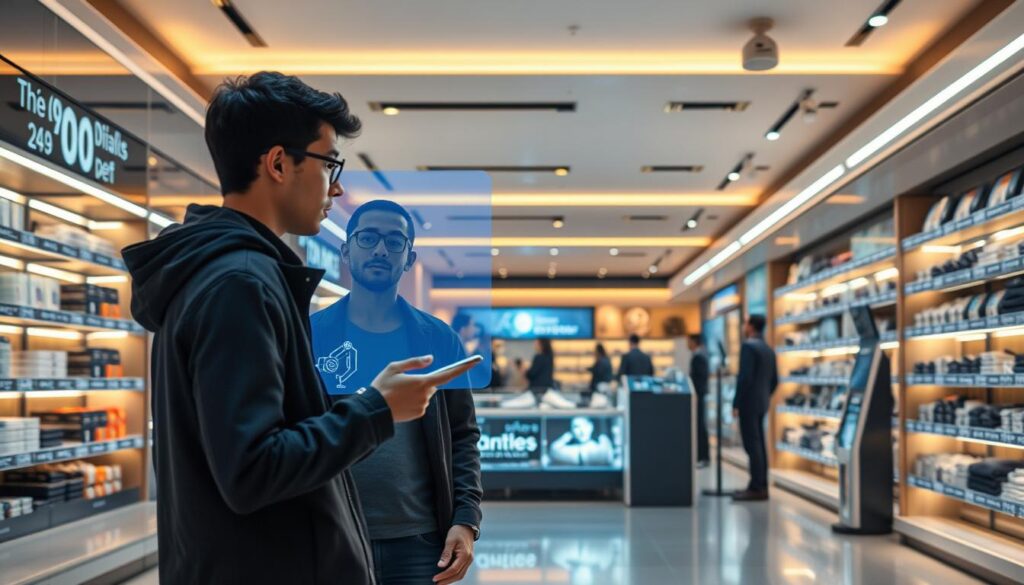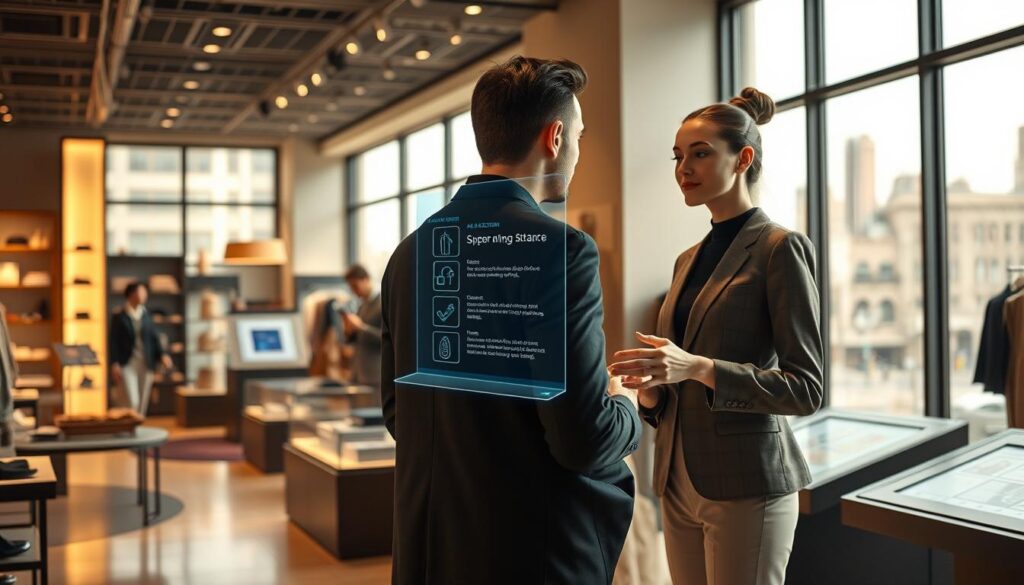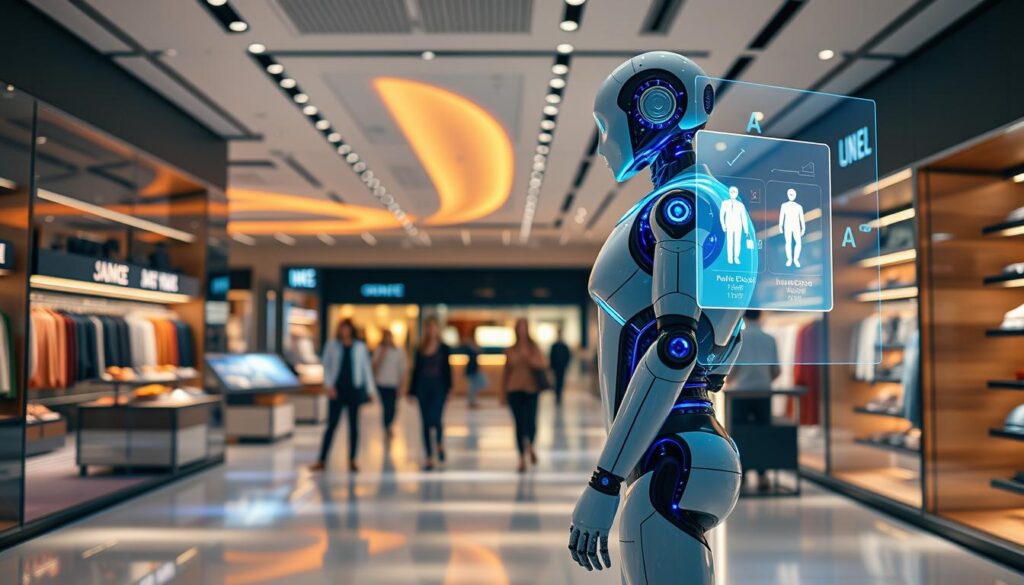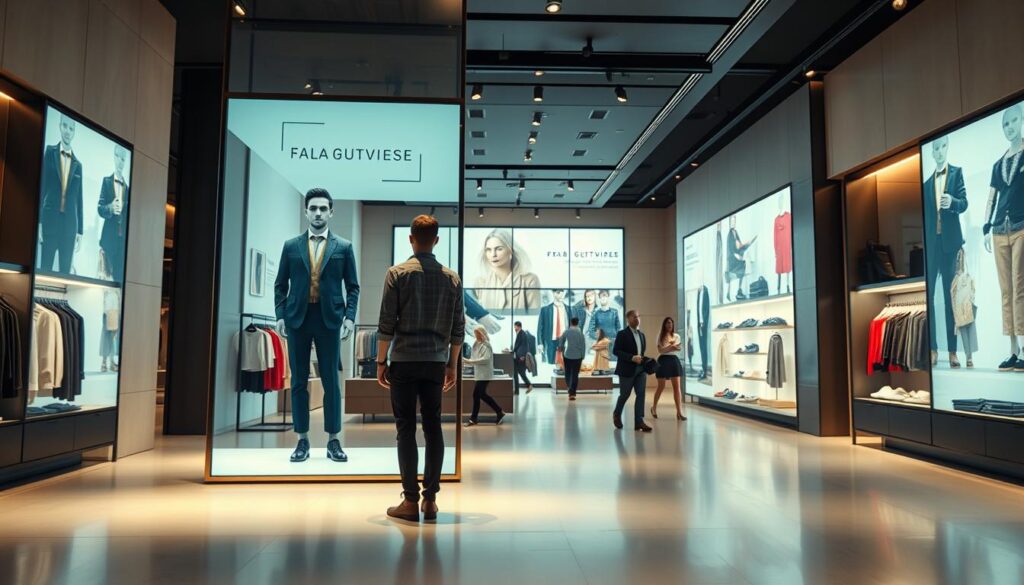As Steve Jobs once said, “Innovation distinguishes between a leader and a follower.” This sentiment rings true in the retail industry, where cutting-edge technology is reshaping how businesses interact with consumers. Artificial intelligence is at the forefront of this transformation, offering tools that streamline operations and elevate the shopping journey.
Retailers are leveraging advanced systems to analyze consumer behavior and preferences. These insights enable businesses to deliver tailored product recommendations, ensuring a more personalized experience. For instance, athletic wear suggestions based on past purchases demonstrate how data-driven strategies can enhance satisfaction and loyalty1.
With the global market for this technology projected to reach $19.9 billion by 2027, its impact is undeniable1. Companies are integrating these solutions to optimize inventory, reduce operational costs, and improve decision-making. The result is a seamless, efficient process that benefits both businesses and consumers.
Key Takeaways
- Advanced systems analyze consumer data for personalized product suggestions.
- Retailers using these tools report up to a 30% reduction in operational costs1.
- Personalized recommendations can increase average order value by 20%1.
- Inventory management solutions reduce stockouts by 30%1.
- 75% of consumers are more likely to purchase with tailored suggestions1.
Understanding the Role of AI in Modern Retail

From traditional cash registers to intelligent systems, retail has come a long way. The industry has shifted from manual processes to data-driven strategies, transforming how businesses operate and interact with consumers. This evolution has been driven by the need to meet growing consumer demands and improve efficiency.
Evolution of Retail Technologies
In the past, retail relied heavily on manual tasks like inventory tracking and sales analysis. These processes were time-consuming and prone to errors. With the advent of digital tools, retailers began adopting point-of-sale systems and basic analytics. These early technologies laid the foundation for more advanced solutions.
Today, retailers are leveraging artificial intelligence to automate tasks and gain deeper insights into consumer behavior. For example, Amazon’s use of AI-powered recommendation engines has set a benchmark for personalized shopping experiences2. This shift has enabled businesses to optimize operations and deliver better service.
The Rise of AI in Customer Interactions
Artificial intelligence has revolutionized how retailers engage with their customers. Smart recommendation algorithms, once limited to e-commerce, are now enhancing in-store experiences2. These tools analyze consumer preferences to suggest products tailored to individual needs.
Major retailers like Walmart have also embraced AI-driven solutions. Their virtual assistants provide immediate support, improving customer satisfaction2. This technology bridges the gap between research and purchase, making the shopping journey more seamless.
For more insights on how AI is shaping industries, explore AI trends in finance.
Personalized Shopping Through AI: Enhancing Customer Experience

The modern shopper expects more than just products; they seek tailored experiences. Businesses are leveraging advanced tools to meet this demand, creating interactions that feel unique and relevant. By analyzing consumer behavior and preferences, companies can deliver personalized recommendations that resonate with individual needs3.
Tailored Recommendations and Consumer Insights
One of the most impactful applications of this technology is in product suggestions. Machine learning algorithms analyze past purchases, browsing history, and even search patterns to predict what a shopper might need next. For example, a fitness enthusiast might receive recommendations for athletic wear based on their previous buys3.
Conversational tools also play a crucial role. These systems confirm customer needs before offering suggestions, ensuring accuracy and relevance. This approach not only improves satisfaction but also boosts sales by aligning products with individual preferences4.
The integration of consumer insights into modern platforms has transformed the shopping journey. Retailers can now offer real-time discounts or flash sales tailored to a shopper’s immediate context, increasing the likelihood of purchase3. This level of personalization fosters loyalty and enhances the overall experience.
By combining data analytics with advanced recommendation technologies, businesses are setting new standards in the industry. The result is a seamless, engaging process that benefits both the company and the consumer.
Leveraging Data and Analytics in Retail AI

Data has become the backbone of modern retail strategies. By analyzing real-time information, businesses can predict trends and make informed decisions. This approach ensures that companies stay competitive in a rapidly evolving industry.
Real-Time Data Processing and Trend Prediction
Retailers are using advanced tools to process streaming data. This allows them to anticipate consumer behavior and adjust strategies quickly. For example, predictive analytics can forecast demand for specific products, reducing stockouts by 20%5.
Real-time insights also enable businesses to launch targeted promotions. Flash sales based on live inventory levels have been shown to increase revenue by 15%5. This level of agility is essential in today’s fast-paced market.
Integrating Multiple Data Sources for Accuracy
Combining data from various platforms ensures greater precision. Social media interactions, website behavior, and past purchases all contribute to a comprehensive view of the consumer. This integration helps retailers deliver personalized recommendations that drive engagement6.
For instance, H&M’s generative AI chatbot uses multiple data streams to reduce response times by 70%6. Such applications highlight the importance of accurate, unified information in enhancing the shopping experience.
By leveraging these strategies, businesses can improve customer satisfaction and loyalty. The result is a more efficient, data-driven approach that benefits both the company and the consumer.
AI Agents in Retail: Enhancing Customer Shopping Experiences

The retail landscape is evolving rapidly, driven by advanced technologies. These tools are transforming how businesses interact with their audience, creating more personalized and efficient shopping journeys. By leveraging data-driven strategies, companies can deliver tailored experiences that meet consumer expectations7.
One of the most significant impacts of these technologies is the ability to streamline tasks. For instance, automated assistants handle inquiries, reducing response times by up to 70%8. This not only improves efficiency but also enhances customer satisfaction. Retailers like Walmart and Amazon are leading the way, integrating these solutions to offer seamless support7.
Both online and physical stores benefit from these advancements. Online platforms use intelligent tools to provide product recommendations, increasing engagement by 31%7. Meanwhile, brick-and-mortar locations leverage these systems to manage inventory and improve in-store experiences. This dual approach ensures a consistent and enjoyable journey for shoppers8.
Operational efficiency is another key advantage. By automating repetitive tasks, businesses can reallocate resources to focus on strategic initiatives. This shift not only reduces costs but also boosts loyalty, as customers receive faster and more accurate support8.
As the industry moves forward, the integration of these tools will continue to shape the future of shopping. For more insights on how technology is transforming other sectors, explore AI innovations in finance.
Innovative AI Solutions: Chatbots, Virtual Assistants and Beyond

The integration of advanced tools is reshaping how businesses connect with their audience. These solutions go beyond traditional methods, offering instant support and personalized interactions. Companies are leveraging these technologies to enhance the shopping journey and streamline operations.
24/7 Support and Instant Responses
Chatbots and virtual assistants provide round-the-clock assistance, ensuring immediate responses for shoppers. This 24/7 availability caters to late-night shoppers and improves overall satisfaction9. For example, Amazon’s virtual assistant handles inquiries efficiently, reducing response times by up to 70%10.
These tools can manage multiple interactions simultaneously, enhancing scalability compared to human teams9. By automating routine tasks, they free up human agents to focus on complex issues, boosting productivity9.
Natural Language Processing and Conversation Management
Advancements in natural language processing enable these tools to understand and respond to queries accurately. GPT models, like OpenAI’s ChatGPT, automate responses to frequently asked questions, improving efficiency10.
Retailers using these solutions report higher engagement and loyalty. For instance, personalized recommendations based on browsing history have increased conversion rates significantly11. This level of precision ensures a seamless and enjoyable experience for the consumer.
By integrating these innovations, businesses can reduce waiting times and enhance service efficiency. The result is a more connected and satisfying shopping journey for every customer.
Transforming In-Store Experiences with Augmented Reality and AI Mirrors

The fusion of technology and retail is redefining how consumers interact with products. Physical stores are no longer just about browsing shelves; they’re becoming hubs of innovation. Augmented reality (AR) and AI mirrors are at the forefront of this transformation, creating immersive journeys that captivate shoppers.
Virtual Try-Ons and Immersive Shopping Journeys
One of the most exciting advancements is the use of AR for virtual try-ons. Shoppers can now see how clothing, accessories, or even makeup looks on them without physically trying it on. This technology reduces purchase hesitation and boosts confidence in buying decisions12.
AI mirrors take this a step further by offering personalized recommendations. These mirrors analyze the shopper’s preferences and suggest products that match their style. For example, Macy’s reported a 10% increase in online sales after implementing predictive analytics for personalized experiences12.
These tools also create a seamless blend of digital and physical retail. Shoppers can explore products in a fun, interactive way, making the journey more enjoyable. Studies show that 55% of consumers choose brick-and-mortar stores for the engaging experiences they offer12.
Retailers like ASOS are leveraging machine learning to tailor recommendations, leading to higher engagement and sales12. By integrating these technologies, businesses can enhance satisfaction and build stronger connections with their audience.
The result is a shopping journey that feels both modern and personal. As these tools become more widespread, they’re setting new standards for what consumers expect from in-store experiences.
Optimizing Operations and Loyalty Programs with AI Integration
Behind every seamless shopping journey lies a blend of technology and strategy. Businesses are leveraging advanced tools to streamline operations and enhance loyalty programs, creating a more efficient and personalized experience for their audience.
Streamlining Store Operations and Inventory Management
Efficiency is at the core of modern retail. By automating repetitive tasks like inventory tracking, businesses can reduce manual errors and save time. For instance, intelligent systems can predict demand, reducing stockouts by 50% and overstock by 30%13.
Real-time updates ensure accuracy across all channels. This integration allows retailers to adjust strategies quickly, improving operational efficiency and reducing costs14. The result is a smoother process that benefits both the business and the consumer.
Personalized Loyalty and Reward Strategies
Loyalty programs are evolving with the help of data-driven insights. By analyzing individual behaviors, businesses can craft personalized offers that resonate with their audience. This approach increases retention rates by 20%14.
For example, dynamic rewards based on purchase history and browsing patterns have proven effective. Retailers using these strategies report higher engagement and customer lifetime value15. This level of personalization fosters stronger connections and encourages repeat visits.
As one industry expert noted, “The future of loyalty lies in understanding the unique needs of each consumer.” By integrating these tools, businesses can create experiences that feel both modern and meaningful.
Industry Case Studies and Real-World Applications
Retail giants are setting new benchmarks by integrating advanced technologies into their operations. These innovations are reshaping how businesses interact with their audience, offering personalized and efficient solutions. From online platforms to physical stores, the impact is undeniable.
Examples from Leading Retailers and Technology Giants
Amazon uses generative tools to suggest products based on browsing history and past purchases, enhancing the customer experience and boosting conversion rates16. Similarly, Stitch Fix employs sophisticated algorithms for personalized clothing suggestions, improving satisfaction levels16.
IKEA’s virtual assistant helps shoppers visualize products in their spaces, increasing buyer confidence and reducing hesitation16. Sephora’s chatbot offers tailored beauty recommendations, enhancing engagement and support16. These examples highlight how technology is transforming the shopping journey.
The Emergence of the Agentic Era in Commerce
The “Agentic Era” refers to a shift where intelligent systems take on more proactive roles in commerce. For instance, Carrefour’s Hopla chatbot tailors product suggestions to dietary preferences, streamlining purchasing decisions16. Walmart’s system continuously monitors inventory across stores, improving efficiency and availability16.
Industry experts predict that this era will redefine how businesses operate. “The future lies in systems that anticipate needs and deliver solutions seamlessly,” says one analyst. Retailers leveraging these tools are seeing measurable results, from reduced costs to increased loyalty17.
For more insights on how AI agents are transforming industries, explore this detailed analysis.
Conclusion
The future of commerce is being reshaped by intelligent systems that deliver personalized and efficient solutions. These tools enhance the shopping experience by offering tailored product recommendations and real-time insights, ensuring every interaction feels unique18.
By adopting these technologies, businesses can streamline operations and improve customer engagement. For instance, automated systems reduce costs by 30% while boosting satisfaction levels19. This dual benefit highlights the importance of embracing innovation in a competitive market.
Real-time datum processing enables businesses to make informed decisions, optimizing inventory and pricing strategies18. These advancements not only improve efficiency but also foster loyalty, as consumers receive faster and more accurate support.
As the industry evolves, intelligent systems will continue to play a pivotal role in shaping the future of commerce. Retailers who integrate these tools now will stay ahead, offering seamless and engaging experiences that meet modern expectations.
FAQ
How do artificial intelligence tools improve the shopping journey?
What role does data play in enhancing retail experiences?
Can technology like augmented reality transform in-store visits?
How do loyalty programs benefit from artificial intelligence?
What are the advantages of using chatbots in retail?
How do leading companies apply these technologies in real-world scenarios?
What is the future of artificial intelligence in the retail industry?
Source Links
- Retail AI Agents: Your Complete Guide
- How AI Is Transforming In-Store Customer Experiences in Retail
- 5 ways of enhancing customer experience in retail with AI
- AI-powered retail: Elevating customer experience and operational efficiency – Microsoft Industry Blogs
- AI and Retail: Enhancing Customer Experience and Operational Efficiency
- Leveraging AI for Enhanced Customer Experience in Retail
- How AI Assistants are Already Reshaping Shopping – Retail TouchPoints
- Data Pilot
- AI in Customer Service: Revolutionizing Digital Retail
- The Commerce Industry is Quick to Adopt Digital Transformation and is Leaning Into AI
- How AI Agents in Retail Are Transforming E-commerce?
- Firework | Harnessing the Power of Artificial Intelligence in Retail and E-commerce: The Ultimate Guide
- AI in Retail: Transforming the Shopping Experience I Novus
- The Role of AI Agents in Modern Retail – From Chatbots to Virtual Assistants | 10xDS
- Loyalty Program Management AI Agents
- Generative AI for Retail: Use Cases with Real-Life Examples
- Transform Retail with AI Agents: Boost Sales & Customer Loyalty
- How AI Agents Are Revolutionizing E-Commerce and Retail
- How an AI Agent Can Boost the Retail Commerce Experience







